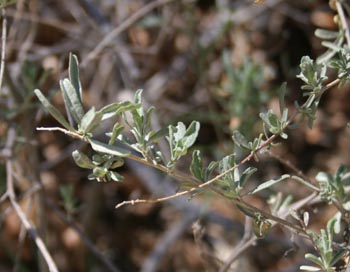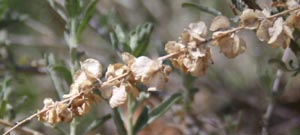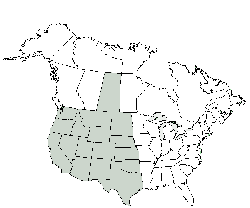Four-wing Saltbush
Common Names: Chamise, chamize, chamiso, white greasewood, saltsage, fourwing shadscale, bushy atriplex, four-wing saltbush, four wing saltbush

Description: Fourwing saltbush is deciduous to evergreen, depending on climate. Its much-branched stems are stout with whitish bark. Mature plants range from 1 to over 8 feet in height, depending on the soil and climate. Its leaves are simple, alternate, linear to narrowly oblong covered with fine whitish hairs and ½ to 2 inches long. Its root system is branched and commonly very deep (to 20 feet) when soil depth allows.

Male and female flowers are commonly on separate plants. Male flowers are red to yellow and form dense spikes at the ends of the branches. The female flowers are axillary and nondescript. Fourwing saltbush plants can exhibit male and female parts in one flower. The seed is contained in cases that turn a dull yellow when ripe and may remain attached to the plant throughout winter.
Location: Four-wing saltbush is a widely distributed shrub on rangelands in the western United States including the Intermountain, Great Basin, and Great Plains regions (see map). Its natural range extends from below sea level to above 8,000 feet elevation. Land owners and agencies use fourwing saltbush for reclamation of disturbed sites

Edible: Fresh roots can be boiled with a little salt and drunk for stomach pain and as a laxative. Leaves and young shoots can be added to soups and stews. Soapy lather from leaves can be used for itching and rashes from chickenpox or measles. Fresh leaf or a poultice of fresh or dried flowers or roots can be applied to ant bites and bee stings.
Native Americans used ashes from the leaves as a substitute for baking powder.
Seed generally ripens in late August and September and can be harvested from mid September through December. The seeds can be ground into meal. Seed yields may range from 200 to 400 pounds per acre.
Notes of interest: Saltbush is high in carotene and averages about four percent digestible protein. The leaves may be as high as 18 percent total protein. It is important for both wildlife and domestic animals.
The blossoms and twigs can make a yellow dye.